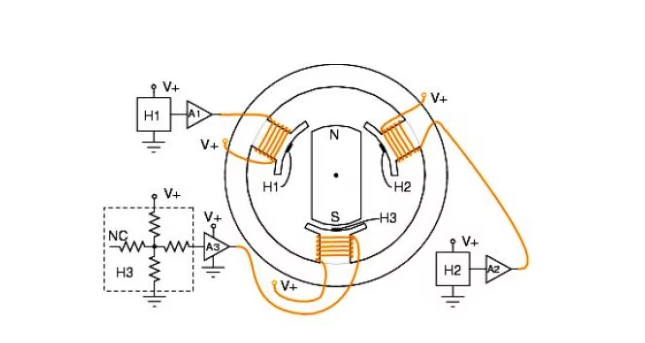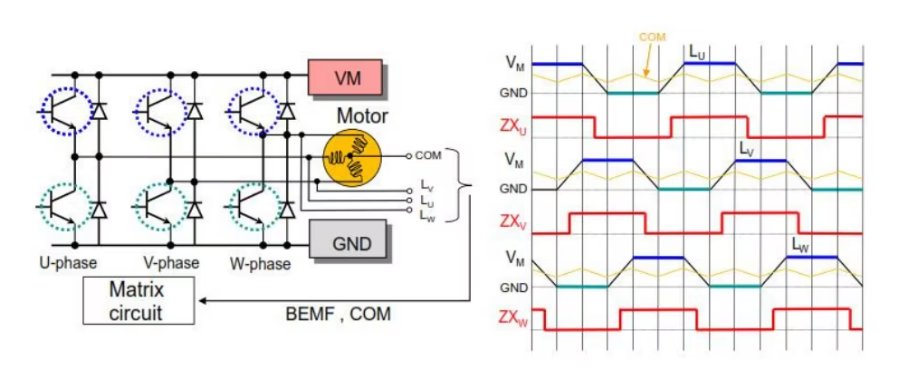
Unlike the mechanical self-commutation of traditional brushless DC motors, three-phase permanent magnet brushless DC (hereinafter referred to as "BLDC") motor control requires an electronic commutation circuit. In this article, we begin with a brief review of how BLDC motors work, followed by an introduction to the characteristics, advantages and disadvantages of the two most widely used commutation methods in terms of complexity, torque fluctuations and efficiency. We then propose an innovative BLDC commutation method and explore the features and benefits of a new motor controller integrated circuit (IC) from onsemi that can choose from any of the three commutation methods.
BLDC structure
BLDC motor is a rotary motor consisting of a three-phase armature winding on the stator and a permanent magnet on the rotor. The mechanical structure of the BLDC motor is opposite to that of the traditional permanent magnet brushed DC motor. The rotor is equipped with a permanent magnet and the stator is equipped with a motor winding. However, as the name suggests, BLDC motors have no brushes and require no regular maintenance or replacement, making them less susceptible to wear and tear. The permanent magnet on the BLDC rotor provides a constant magnetic field, making it a high-efficiency, high-torque, low-moment of inertia motor. BLDC's reliability and variable speed drive make it popular in a wide range of applications, including white appliances, heating, ventilation and air conditioning (HVAC), automotive and industrial machinery, and robotics.
The commutation circuit of three-phase BLDC motor is usually implemented by discrete components or MCU and integrated power module. Designs using discrete components require a lot of design expertise and experience to build and troubleshoot, and take a certain amount of time to implement. Dedicated motor control ics with discrete power stages have become a more popular approach because little additional circuitry is required and many manufacturers offer dedicated companion software for their products, which greatly simplifies setup and commissioning. A fully discrete solution usually minimizes the component costs of the solution. However, a more integrated solution can reduce overall system costs by reducing PCB area and manufacturing steps - minimizing Bill of material (BOM) components, reducing inventory costs, and facilitating rapid reuse of iterations in new designs - and improve overall solution reliability. Now, On also offers a dedicated control IC with discrete power stages.
BLDC control
Unlike typical brushed DC motors, BLDC motor control systems are called inverters. It includes a power stage to drive the motor, a counter-potential signal detection amplifier to sense sensorless work, an encoder or Hall sensor for sensorless work, and an McU-based controller. The controller converts the feedback information of speed and position into the appropriate PWM signal to realize the dynamic control of the motor. Inverter systems have many advantages that offset their disadvantages in terms of cost and complexity: higher reliability and energy efficiency, less noise, wider operating range, and excellent control of speed and torque. To design a BLDC brushless DC inverter system, you also need expertise in electronic design, layout, and firmware programming, as well as the tools and resources to do the job.
Trapezoidal control and field oriented control (FOC, also known as vector control) are two commutation algorithms widely used in BLDC systems. Trapezoidal commutation is the simplest, but it is the least efficient and the most noisy method. FOC is more complex to implement, but is generally quieter and more efficient. Both methods can work with or without sensors.
Figure 1: BLDC represents the Hall sensor position

Trapezoidal reversal
Trapezoidal commutation uses two power switching devices on each motor phase that follow a pre-determined "on-off" sequence. This approach is popular because the control algorithm is simple and can be implemented based on the most basic MCU. Ladder control is very effective in controlling motor speed, but it is the least efficient method. Nevertheless, it is subject to high torque fluctuations during commutation, especially at low speeds, and trapezoidal commutation is popular in low-end applications where simple closed-loop operation is required.
Due to the nonlinearity, there are huge fluctuations in torque, and only two of the three motor windings have current flowing through them at any given time. As a result, nonlinear factors create noise and vibration, and overall performance is limited because the current controller must be slow enough not to respond to transients as the current travels from phase to phase. The 180° commutation method can produce high torque through trapezoidal commutation, but the 120° commutation minimizes torque fluctuations. The switching sequence is determined in order to perform two consecutive motor phases (60° apart) while the motor is rotating.
Figure2:6-step ladder control waveform 
Field-oriented control
FOC is a more complex commutation method with higher processing requirements and is more suitable for high-end applications. The advantages of FOC over trapezoidal commutation include precise positioning, higher speed, lower torque fluctuations and lower noise, as well as higher power efficiency. With the FOC commutation method, the motor can calculate voltage and current vectors based on the motor current feedback, thus achieving sensorless commutation, but Hall effect sensors can also be utilized if the application requires it.
FOC maintains high efficiency over a wide operating voltage range, enabling precise dynamic control of speed and torque. In FOC, the three stator currents represent a vector composed of orthogonal torque and flux components. Clark and Parker's mathematical transformations convert alternating current and voltage waveforms at different times to DC values, greatly simplifying downstream processing requirements. The main drawback of FOC is the need for increased processing power, which may require a more powerful MCU.
Direct torque and flux control
While DTC and DTFC have been around for some time, Theta Power Solutions, Intl (TPSI) has developed a new sensorless BLDC commutation method that directly controls torque and magnetic flux. While DTFC is not a new concept, TPSI has developed a unique and more efficient way to provide flux weakening to BLDC motors for increased high-speed capability. It is ideal for braking algorithms that provide controlled deceleration with high inertial loads.
It uses a high-speed data bus that transmits real-time motor feedback to provide a control current of maximum torque per ampere (MTPA). It ensures the high efficiency of the motor under all load conditions, even at saturation, and has a thermal compensation function that allows the motor to operate uninterrupted or at extreme temperatures. For applications that require precise torque at very low speeds, TPSI's sensorless solutions offer an excellent solution, allowing users to reduce system costs by eliminating the need for sensors.
The advantages of TPSI's solution over traditional DTC (and FOC) include, but are not limited to:
● Enables closed-loop start-up with very low current requirements
● Excellent stability over a wider range of speeds
● Sensorless operation
● High-speed telemetry allows the motor to be used as a sensor
● Maximum torque per ampere
● Noise minimization
● Easy to scale performance
● Excellent low speed performance (~5Hz), no sensor required
● Excellent torque regulation over the entire speed range
● The user interface simplifies the process and allows the motor to run quickly
TPSI's DTFC requires additional processing power to implement. The ECS640A is the industry's first product to implement this advanced control technology based on an Arm® Cortex®-M0+ class MCU.
3 in 1 control options
On's ecoSpin™ family of configurable motor controllers can use any of these three control methods. The ECS640A is the first device in this family and is a system level package (SiP) solution. It integrates an Arm® Cortex-M0 + microcontroller, three detection amplifiers, a reference amplifier, three bootstrap diodes, and a high-voltage gate driver designed for high-voltage, high-speed operation, all in a 10mmx13mm QFN package. It can drive MOSFETs and IGBTs (FAN73896) with operating voltages up to 600V and has six gate driver outputs that deliver 350mA/650mA (typical values) gate current to external power devices. The device includes GPIO Hall sensor inputs to support the desired sensing operation and has three independent low-end source pins that allow for single or multiple shunt measurements.

The small size and high integration make the device ideal for use with discrete power devices to maximize scalability. It comes with a software development Kit (SDK) consisting of a flash loader, device boot and system files, peripheral drivers (CMSIS-Driver style), and sample code for peripheral demonstrations. On is also affiliated with Theta Power Solutions, Inc. Collaborate to provide DTFC firmware for the ECS640A. This enables optimal motor performance on Arm Cortex-M0+ processors without the need for more powerful and expensive MCU solutions to perform commutation.
The easy-to-use graphical user interface simplifies code development and speeds product to market. Users will appreciate this integrated solution, which automatically generates coefficient parameters for the specific motor used, making the system easy to set up and able to run quickly without errors due to loose details of the rotating motor.
Flexibility and integration
BLDC motors are becoming more and more popular in a variety of applications, but they need to be properly changed to take full advantage of their advantages. When choosing a BLDC motor controller IC, it makes sense to choose the IC that offers the most commutation options and a high degree of integration. On's ECS640A motor controller offers flexibility and ease of use for both sensorless and sensorless applications.
Heisener Electronic is a famous international One Stop Purchasing Service Provider of Electronic Components. Based on the concept of Customer-orientation and Innovation, a good process control system, professional management team, advanced inventory management technology, we can provide one-stop electronic component supporting services that Heisener is the preferred partner for all the enterprises and research institutions.
